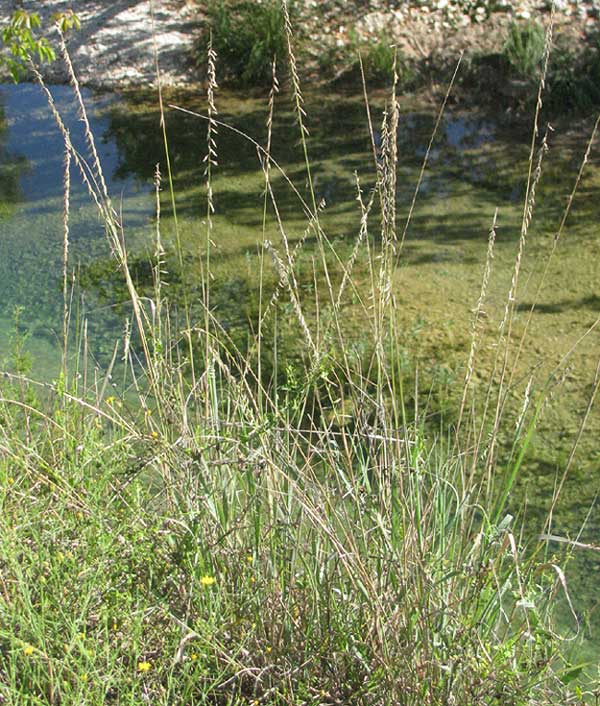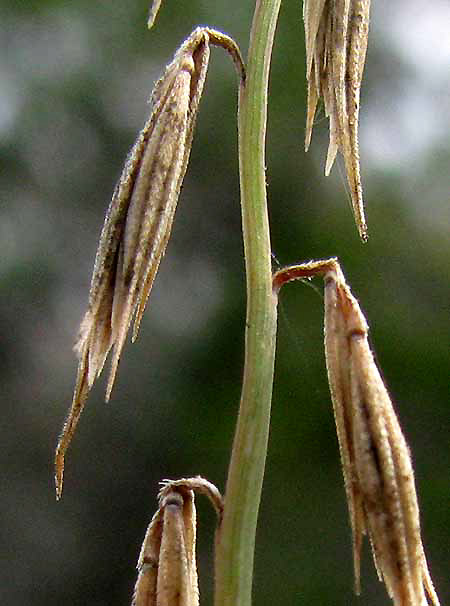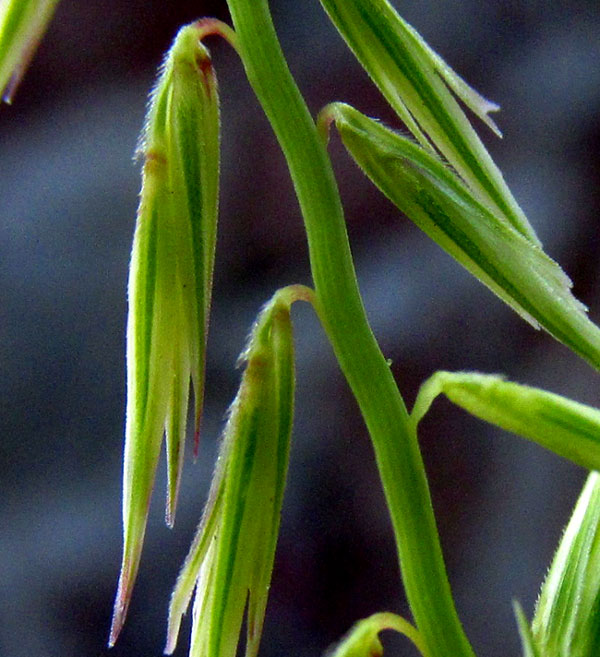Excerpts from Jim Conrad's
Naturalist Newsletter

from the the September 30, 2012 Newsletter issued from the valley of the Dry Frio River in northern Uvalde County, southwestern Texas, on the southern border of the Edwards Plateau; elevation ~1750m (~5750 ft); N29.62°, W99.86°; USA
SIDEOATS GRAMA
In a variety of habitats, but especially on limestone outcrops along the little Dry Frio River behind the cabin, there's a certain knee-high clumpgrass fruiting in a very conspicuous and unusual manner nowadays. You can see a clump with the Dry Frio's shallow waters in the background above.
The "slender pagoda" effect, with the clusters of spikelets hanging downward -- "pendent," as botanists say -- is a fine field mark. And this is a grass worth knowing since it's one of the main native short-grass prairie species throughout the Americas, from Canada to Argentina. It's so important for grazing cattle that it's the State Grass of Texas. Usually called Sideoats Grama, it's BOUTELOUA CURTIPENDULA.
In Texas Senate Concurrent Resolution #31, among several "whereases" explaining why Sideoats Grama should be the state grass, there's the following:
"WHEREAS, Although there are many desirable forage species native to the State, one variety, sideoats grama, occurs on a greater diversity of soils than possibly any other grass; on rangelands of West Texas it is the backbone of the ranching industry; and
WHEREAS, Sideoats grama produces a high quality, nutritious forage which is relished by all classes of livestock and wildlife; it is one of the State's most attractive grasses as well, with its brilliant orange anthers and the purple inflorescence it produces upon maturity; each spike turns to one side of the seed stalk at maturity, giving the grass its name of sideoats; and
WHEREAS, This grass is also favored because it is not only winter hardy but is highly drought resistant due to the fact that it is a long-lived perennial grass with rhizomes; in some years the grass produces two seed crops, and growth begins early in the spring and continues until early fall; and... "
If you're familiar with grass-flower structure you'll recognize that Sideoats Grama's flowering and fruiting heads are a bit unusual. You can see some up close below:

You can review glass-flower anatomy on our grass page at http://www.backyardnature.net/fl_grass.htm.
The tricky thing with Sideoats Grama flowers is that each compact, pendent item in the picture is not a spikelet but rather a cluster of spikelets. In grass-talk, a spikelet is a unit holding one or more florets (flowers). For most grasses such clusters are spikelets, but Sideoats Grama crams one to eight spikelets into a cluster, and then each spikelet contains one or two florets. Also, in most grasses once the achene-type fruits are ready to fall, either a floret falls from its spikelet, or a spikelet falls from the stem, but with Sideoats Grama the whole group of spikelets falls as a unit.
So, this is one of the most important flowering native plants in the Americas, yet few people have heard of it. It occurs throughout the US and much of Canada, though in Kentucky and Mississippi I saw it only rarely, normally in especially dry natural areas. Really, Sideoats Grama prefers drier habitats than normally found there.
entry dated June 18, 2022, issued from near Tequisquiapan; elevation about 1,900m, (6200 ft), ~N20.57°, ~W99.89°; Querétaro state, MÉXICO
SIDEOATS GRAMA IN MEXICO

At the very end of an especially rainless, long dry season, out in the scrub I met an old friend in the shade of a stone fence, shown above. It was Sideoats Grama, Bouteloua curtipendula, often seen back in our Texas days. Wandering livestock had clipped just a few blades, but in this grossly overgrazed landscape it's a wonder it existed at all. Maybe sheep and cattle are afraid to graze where they can't see who's on the other side of a short stone wall anchoring the end of a fence.
Sideoats Grama is easily recognized by the manner in which the flowering heads align themselves on the rachis, shown below:

The older flowering heads angle downwards. Also, it's hard to see in the photo, but the heads arise from the rachis opposite one another, so they form a flat plane, like barbs on a feather. However, the plane gradually twists, explaining why in the picture the inflorescence is narrower at the top. The top has flowering heads sticking out from it, too, but we're seeing the plane they form sideways. Here are some flowers up close:

In the above section written in Texas, the unusual and confusing structure of the flower clusters is mentioned. In the above picture, if you understand basic grass flower structure, you can better see than before what's so unusual. In Sideoats Grama, what looks like a spikelet is actually a group of spikelets. As I wrote then, "Sideoats Grama crams one to eight spikelets into a cluster, and then each spikelet contains one or two florets." Our grass structure page still explains those terms.
I'm surprised to find Sideoats Grama down here, but now I read that three varieties are recognized for the species. Two occur in North America, but in Mexico we have a third, which this is. This is Bouteloua curtipendula var. tenuis. I read that the species' native distribution extends from North America, including Canada, to southern Argentina.